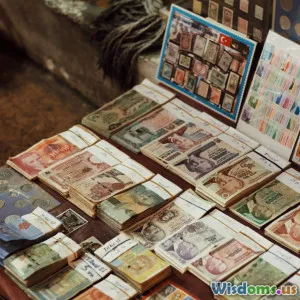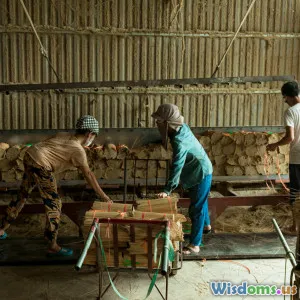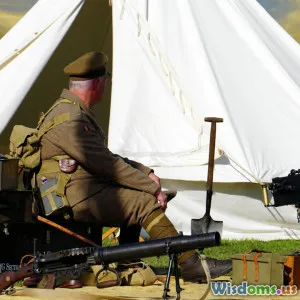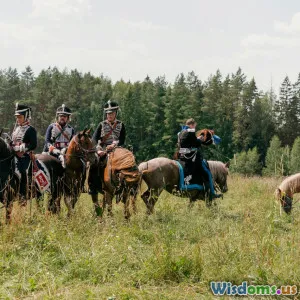
Barter vs Money Exploring the Shift that Changed Ancient Trade Forever
9 min read Discover how the transition from barter to money revolutionized ancient trade and laid the foundation for modern economies. (0 Reviews)
Barter vs Money: Exploring the Shift that Changed Ancient Trade Forever
Introduction: The Dawn of Trade and Its Challenges
Imagine a world where exchanging goods meant finding someone who not only had what you wanted but also wanted exactly what you had. This was the reality for our ancient ancestors relying on barter systems — a method of trading goods and services directly without any medium of exchange. While barter was foundational, it contained inherent inefficiencies that eventually necessitated an evolutionary leap toward something more flexible and universal: money.
This article delves deep into the significant shift from barter to money, revealing how this transformation reshaped ancient trade forever. You'll understand the mechanics of barter, the driving forces that led to the adoption of money, and how money's advent forged the backbone of modern economies.
Understanding Barter: The Earliest Economic Exchange
What Was Barter?
Barter, in its simplest form, involved the direct exchange of goods or services without a medium of exchange. Early societies would trade surplus crops for tools, or handmade pots for livestock, relying on mutual wants and immediate value matches.
Limitations of Barter
Despite its intuitive nature, barter presented critical challenges — famously coined by economists as the “double coincidence of wants.” For a barter to occur, both parties needed to desire what the other offered, simultaneously. This rare alignment stifled expanded trade. Consider a farmer with surplus wheat needing a new spearhead: if the blacksmith wanted no wheat but preferred cattle, the trade couldn't happen directly unless multiple intermediaries got involved.
Lack of Standardization
Value assessment was subjective in barter; how many bushels of grain equated to one spear? Without consistent measures, perceived value was variable and often led to conflicted negotiations.
Examples in Ancient Societies
- In Mesopotamia, early city-states like Ur and Babylon relied heavily on barter for local trade before money’s formal adoption.
- Pacific island societies also thrived on barter, exchanging items like mats, fish, and shells suited to their environment.
While barter nurtured the initial growth of economies, these drawbacks spurred experimentation with more versatile trading tools.
The Birth of Money: Overcoming Barter’s Constraints
The Concept of Money as a Medium of Exchange
Money emerged as an innovative solution, serving as a generally accepted medium of exchange to replace the cumbersome barter barter system. There are three fundamental qualities money needed:
- Durability: Money should last over time and use.
- Portability: It should be easy to carry and transfer.
- Divisibility: It must allow transactions of varying values.
Early Forms of Money
Commodity money laid the groundwork — valuable objects like shells, salt, cattle, or metals acted as proxies for value.
- In ancient China, cowry shells were among the earliest accepted currency, prized for rarity and beauty.
- The use of precious metals such as gold and silver began around 3000 BCE in regions like Mesopotamia and Egypt, providing intrinsic value and ease of standardization.
Coinage and Official Currency
The Lydian Kingdom (in modern-day Turkey) is credited with minting the world’s first coins around 600 BCE. Using stamped precious metals with official designs, coins guaranteed weight and standard value, which facilitated trust in transactions.
According to economic historian David Graeber: “Coins mark a fundamental step in the drift from tangible exchange to abstract economic order.” They not only simplified trade but empowered state control over economies through regulated issuance.
Trade Transformed: How Money Revolutionized Ancient Economies
Resolving the Double Coincidence of Wants
By introducing money, trade no longer depended on matching wants simultaneously. A peasant could sell grain for coins and later use those coins to buy whatever was needed, dramatically increasing flexibility.
Enabling Specialization and Complex Markets
Money’s flexibility allowed societies to specialize economically. Craftsmen, farmers, and merchants could focus on refining skills or products, confident they could trade easily.
- Ancient Athens’ bustling marketplaces demonstrated this, with currency facilitating diverse goods’ flow and growing the city’s wealth.
Encouraging Savings and Investment
Money introduced the notion of storing value, saving for the future, and investing in larger ventures.
- For example, in Roman times, money accumulation enabled trade expeditions that spanned vast parts of Europe and beyond, accelerating wealth accumulation.
Taxation and State Building
Monetary economies allowed states to collect taxes efficiently and fund monumental projects — from roads to aqueducts — which further stimulated economic activity.
Drawbacks and Challenges in the Transition
Trust and Manipulation
With money taking a central role, it required collective trust in its value; this sometimes led to inflation or debasement.
- Ancient rulers like Roman emperors occasionally reduced the silver content in coins, causing instability.
Social Inequality
The accumulation of money enabled social stratification as wealth concentrated, an economic complexity less visible in pure barter societies.
Cultural and Psychological Shift
Compared to direct barter’s personal negotiations, money transactions abstracted value, sometimes distancing social bonds intrinsic to barter exchanges.
Legacy of the Shift: From Ancient Trade to Modern Economics
The shift from barter to money didn't only solve old trade problems; it laid the foundation for:
- Complex financial institutions
- Credit and banking systems
- Globalized trade networks
Contemporary societies owe their economic structure to this discovery. Today, even as digital currencies and cashless payments emerge, the fundamental principles established millennia ago continue to direct commerce.
Conclusion: A Revolution Written in Currency
The journey from barter to money was not merely a change in payment methods—it was a profound leap that transformed human societies. By transcending barter’s restrictive nature, money unlocked unprecedented economic potential, catalyzed urban growth, and enhanced governmental power.
Understanding this shift is crucial, reminding us how economic tools shape not only market transactions but cultural and social realms. As modern technology alters money’s form again, it’s worth reflecting on its roots and appreciating its power to continually reshape human interaction and progress.
Money is more than coins or notes; it's the foundation upon which civilization’s commerce dances, a timeless innovation that forever changed ancient trade — and every exchange that followed.
References:
- Graeber, David. Debt: The First 5,000 Years. Melville House, 2011.
- Davies, Glyn. A History of Money: From Ancient Times to the Present Day. University of Wales Press, 2002.
- Seaford, Richard. Money and the Early Greek Mind: Homer, Philosophy, Tragedy. Cambridge University Press, 2004.
- Kindleberger, Charles P., and Aliber, Robert Z. Manias, Panics, and Crashes: A History of Financial Crises. Wiley, 2005.
Rate the Post
User Reviews
Popular Posts



















